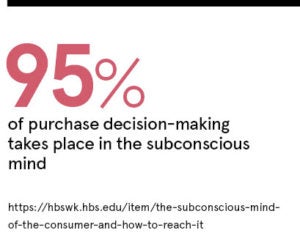Retail is changing faster than ever. Where we shop, when we shop and how we shop have transformed in a short time, creating a huge array of options for time-poor consumers.
The well-documented move to online shopping has been followed by further innovation such as subscription models, with brands like Dollar Shave Club offering alternative ways to buy essentials, in this case razors. All this at a time when consumer attention is hard to capture. So how can brands make sure they aren’t getting left behind?
In this increasingly complex market, insights are key. At the forefront of the move towards better consumer knowledge is eye-tracking, a technology and methodology that goes into the mind of shoppers to give brands an unbiased view of how their products are being engaged.
“These days business decisions are often data driven, based on information from sales, loyalty cards, self-reported survey responses or click-through rates,” explains Jon Ward, head of research and director of Tobii Pro, a leader in eye-tracking solutions that also conducts marketing research on behalf of brands. “Companies need to dig deeper to make properly informed decisions. They need to understand the underlying behaviours that drive people to make purchase decisions.”
Eye-tracking is the process of measuring eye movements to understand where a person is looking, what they are looking at and how long they gaze at a particular spot. An eye tracker is either mounted on to a computer or into wearables and uses invisible near-infrared light, high-definition cameras and advanced algorithms to record eye movement. The data can be viewed live, replayed or exported for further analysis.
“The fantastic thing about eye-tracking is that it gives you insight into every single decision, customer journey interaction and consideration,” says Mr Ward. “We can track people at the shelves, tills, at home using a screen or when they unbox or use their purchases. It’s about understanding the way someone perceives the world, and then how that can be used to create better experiences and meet customer aims.”
Of course, while the retail landscape is transforming, so too are the mindsets of those doing the buying. Millennials have been followed closely by Generation Y and Gen X, who have an entirely new set of purchasing drivers that often include ethics, environmental messaging and health.

“We’re in an incredibly different space and time than we were even three years ago,” explains Mr Ward. “Things that worked back then don’t work now. People are susceptible to social media, digital content and personalised experiences. Brands making assumptions about people based on data from five or ten years ago run the risk of falling behind.”
Understanding customer drivers and behaviours can help brands to come up with solutions for the exact products they’re testing. But those insights can also be applied across the whole business. “The product in question will be better, but so too will future products,” says Mr Ward. “If design mistakes aren’t made, it can have a huge impact, shortening development time and reducing the risk of failure and expensive remakes post-launch.”
The competitive advantage offered by eye-tracking comes back to the unbiased insights gained by going straight to the source. Other forms of customer testing require people to remember their exact actions and reasons for doing things, when many parts of a decision process are unconscious. The ability to see the world through a customer’s eyes, while they’re experiencing your brand, creates the most natural, uninterrupted experience and unbiased insights.
“Author and branding expert Martin Lindstrom once pointed out that if you wanted to observe animal behaviour, you wouldn’t go to the zoo, you’d go to the wild,” says Mr Ward. “This is a good way of looking at what eye-tracking can provide marketers that no other methodology can. If you capture insight the most naturalistic way possible, you have the best data to make better informed business decisions on design, placements and marketing investments. That is what makes companies win in their category today and the underlying principle for winning in the future.”
For more information please visit www.tobiipro.com

